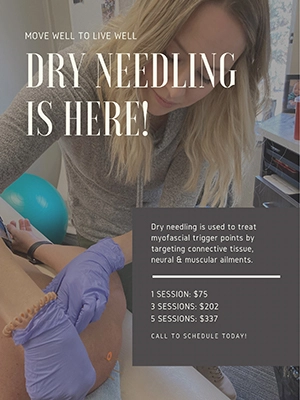Dry Needling
Dry needling in Appleton WI, Manitowoc WI, and Oconto WI is a treatment approach for those who suffer from pain and limitations caused by muscle tightness or tension, stubborn trigger points, or injury to soft tissues such as tendons and ligaments. It involves inserting a small needle into the muscle or tissue as a way to release tension and flood the affected area with healing properties.
What Can Dry Needling Help?
Our in-house therapist is certified in providing dry needling services to all areas of the body, from the face and head for migraines or TMJ issues, to the feet for plantar fasciitis, and everything in between.
If you're wanting more information on how dry needling works or are wondering how it might fit into your treatment plan, don't hesitate to call our office, ask your chiropractor for more information, or stop by our therapist's room and get your questions answered.

PRICING
- 1 session | $80
- 3 sessions | $207
- 5 sessions | $342
Dry Needling FAQs
How exactly does it help?
The exact mechanisms of how dry needling works on a biological level are still being uncovered, but the general understanding is that as the needle is inserted into the tissue (muscle, ligament, or tendon), there are neurological, mechanical, and chemical changes that take place, releasing healing elements and properties into the area and breaking up tension. The ultimate goal is to resolve tightness and tension that is causing pain, mobility restriction, and strength deficits.




